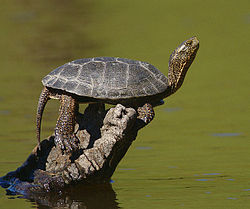Western Pond Turtle
| Western pond turtle | |
|---|---|
 |
|
| Actinemys marmorata. | |
| Scientific classification | |
| Kingdom: | Animalia |
| Phylum: | Chordata |
| Class: | Reptilia |
| Order: | Testudines |
| Family: | Emydidae |
| Genus: | Actinemys or Emys |
| Species: | A. marmorata |
| Binomial name | |
|
Actinemys marmorata or Emys marmorata (Baird and Girard, 1852) |
|
| Subspecies | |
|
Actinemys marmorata marmorata |
|
 |
|
| The range of the Western pond turtle. | |
| Synonyms | |
|
Actinemys nigra |
|
Actinemys marmorata marmorata
Actinemys marmorata pallida
Actinemys nigra
Clemmys marmorata
Clemmys wosnessenskyi
Emys nigra
Geoclemmys nigra
The western pond turtle (Actinemys marmorata or Emys marmorata), or Pacific pond turtle is a small to medium-sized turtle growing to approximately 20 cm (8 in) in carapace length. It is limited to the west coast of the United States of America and Mexico, ranging from western Washington state to northern Baja California. In May 2002, the Canadian Species at Risk Act listed the Pacific pond turtle as being extirpated in Canada.
Its genus classification is mixed. Emys and Actinemys were used among published sources in 2010.
The dorsal color is usually dark brown or dull olive, with or without darker reticulations or streaking. The plastron is yellowish, sometimes with dark blotches in the centers of the scutes. The shell is 11–21 cm (4.5–8.5 in) in length. The dorsal shell (carapace) is low and broad, usually widest behind the middle, and in adults is smooth, lacking a keel or serrations. Adult Western Pond Turtles are sexually dimorphic; that is, males have a light or pale yellow throat.
Western pond turtles originally ranged from northern Baja California, Mexico, north to the Puget Sound region of Washington. As of 2007, they have become rare or absent in the Puget Sound area. They have a disjunct distribution in most of the Northwest, and some isolated populations exist in southern Washington. Pond Turtles are now rare in the Willamette Valley north of Eugene, Oregon, but abundance increases south of that city where temperatures are higher. They may be locally common in some streams, rivers and ponds in southern Oregon. A few records are reported east of the Cascade Mountains, but these may have been based on introduced individuals. They range up to 305 m (1,001 ft) in Washington, and to about 915 m (3,002 ft) in Oregon. They also occur in Uvas Canyon area, Santa Cruz Mts, California.
...
Wikipedia

